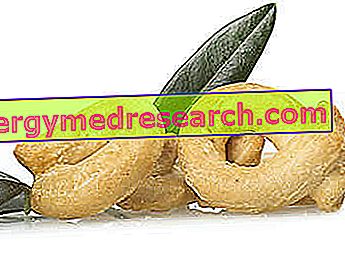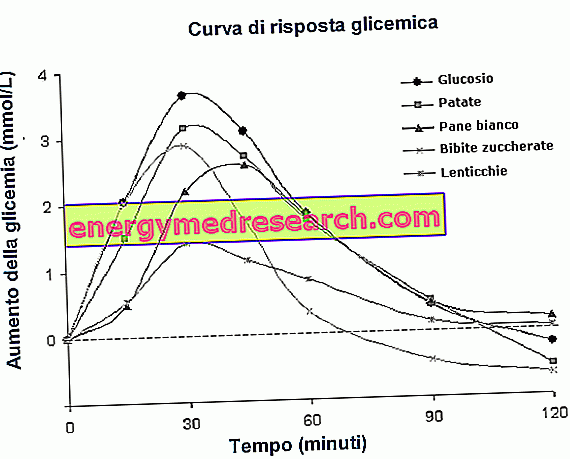Generality
The taralli (also known as " tarallini ") are baked products composed mainly of flour, oil, white wine and salt; they often contain fennel seeds and chili peppers.

The original cooking of the taralli is divided into two phases: the first is done in boiling water (until they emerge), the second takes place in the oven after drying them and requires a high temperature (until they become golden brown). In some places it is used to fry them rather than cook them in the oven, but this leads to an increase in the digestive effort.
On the contrary, to obtain a light recipe, it is necessary to reduce the fat by reducing the amount of extra virgin olive oil in the dough.
To view the details of Alice's recipe on "Taralli Pugliesi Leggeri" click here.
The taralli appear as small golden rings. They are made up by forming a 4-5 cm long worm-like paste, subsequently closed by vertex overlapping. The inner diameter is about 1-1.5 cm and the outer diameter is about 3-3.5 cm. A tarallo weighs about 5 g.
The nutritional characteristics of the taralli are quite similar to those of other baked products such as breadsticks, croutons, crackers, etc. The most significant difference regards the lipid profile which, in the case of taralli, is better than the foods prepared with lard, butter and hydrogenated / bifractionated vegetable oils.
At the table, the taralli can replace bread (even if they do not have the same nutritional characteristics) and accompany various recipes. Some "special" taralli may contain very special ingredients, such as sugar, icing, etc.
However the taralli seem to have greater relevance with the "snacks". In Italy they are also available packaged, in convenient single-portion bags or in larger containers (the latter also produced by craftsmen).
Their practicality has made it possible to classify them among the "finger foods", or foods to be eaten with the fingers.
Home-made Taralli
Light Apulian Taralli
X Problems with video playback? Reload from YouTube Go to Video Page Go to Video Recipes Section Watch the video on youtubeNutritional Features
The taralli are products that should belong to the III fundamental group of foods, or that of the "Cereals, derivatives and tubers".
On the other hand, taralli rich in fats have an energy distribution that favors lipids compared to carbohydrates. This makes them scarcely pertinent to this set, although the same does not apply to the leaner versions.
The taralli are highly energetic foods, with a caloric intake that fluctuates between 400 and 550kcal.
The energy comes essentially from carbohydrates (up to 65% for the lean versions) or from lipids (over 60% for fat versions); proteins are marginal and do not reach 10%.
The fatty acid profile is in favor of monounsaturated fats. Carbohydrates are mainly complex. Peptides have a medium biological value.
Taralli contain a good amount of fiber. If prepared exclusively with oil, they do not provide cholesterol.
As for minerals, taralli show an excellent amount of sodium from cooking salt. The amounts of potassium, magnesium and iron are modest.
With regard to vitamins, the level of thiamine (B1) is appreciated.
NB . If the taralli were produced with whole wheat flour, the quantities of minerals and vitamins would be definitely higher.
Taralli are NOT suitable for clinical nutrition for overweight. They are NOT even suitable for the diet against hyperglycemia, type 2 diabetes mellitus and hypertriglyceridemia.
They are not relevant to the celiac disease diet, but have no contraindications for lactose intolerance.
The oil taralli meet the requirements of the vegetarian and vegan philosophy (the ingredients are exclusively of vegetable origin).
The average portion of taralli, if used as a snack, corresponds to 15-25g (for a total of 70-120kcal that is 3-5 pieces).
Taralli VS Fresh Bread
In the ordinary diet, the taralli should NOT replace the lean bread.
Wanting to use them for this purpose, it is advisable to work on the nutritional composition of other ingredients, reducing the use of seasoning fats in other recipes.
This reduction should be at least 5-15g of oil per 100g of taralli (5-15g of oil corresponds to 45-135kcal). The amplitude of this interval is not accidental, since the recipes of the taralli are not all equal (certain products can show a caloric difference also very relevant compared to others).
Furthermore, it must be specified that the total humidity of the taralli is not more than 10%, while that of fresh bread reaches 35%. The 25% difference greatly affects the concentration of macronutrients and total calories.
Ultimately, taralli can add up to 250kcal more than fresh lean bread; moreover, between one tarallo and the other there could also be 150kcal of difference coming from the lipids.
To give a practical example, in a dinner consisting of:
- Meat 150g.
- Lettuce 50g.
- Bread 100g (4 slices).
- Total extra virgin olive oil 20g (about 2 tablespoons).
if you want to insert the taralli instead of bread, you need to change the portions as follows:
- Meat 150g.
- Lettuce 50g.
- Fat taralli 55g (about 11 pieces of 5g each) or lean taralli 65g (about 13 pieces of 5g each).
- Total extra virgin olive oil 5 or 10g (about half or 1 whole spoon of soup).
Production Area and Tradition
That of the taralli is a typical recipe of the Puglia region, which enjoys the recognition of Traditional Italian Agri-food Product (PAT), conferred by the Ministry of Agricultural, Food and Forestry Policies (MiPAAF).
They are also produced in the surrounding regions (Calabria, Campania, Basilicata, Lazio, Molise and Sicily), although sometimes with rather different recipes (for example the Basilicata aviglianese tarallo).



